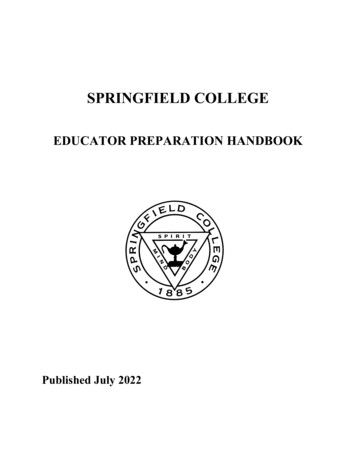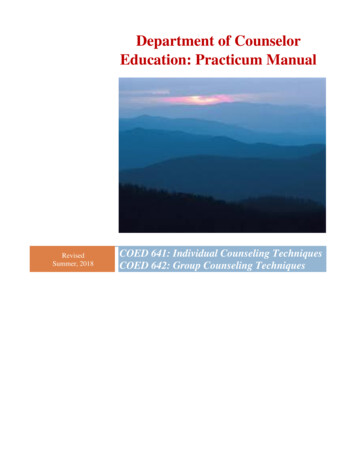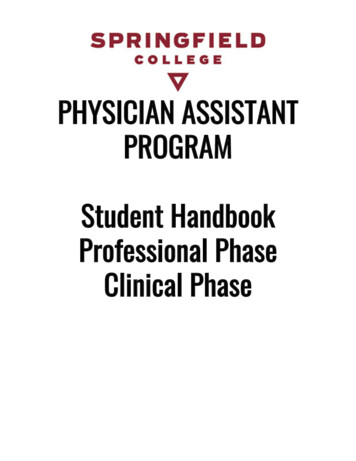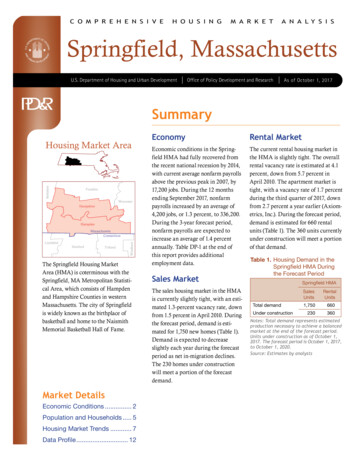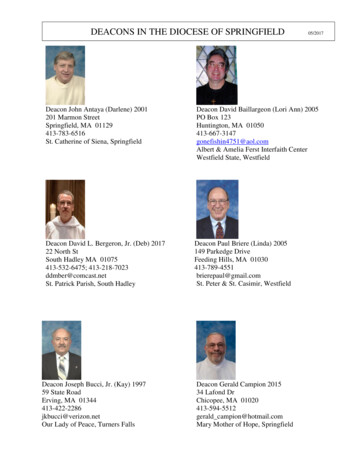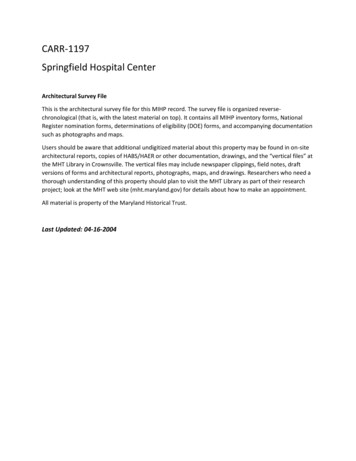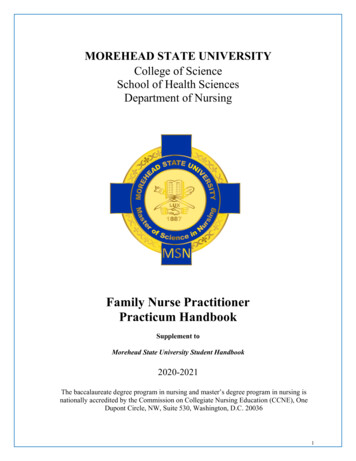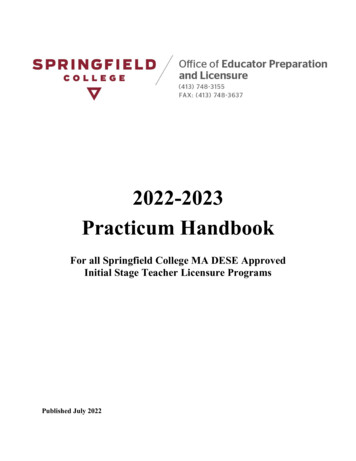
Transcription
2022-2023Practicum HandbookFor all Springfield College MA DESE ApprovedInitial Stage Teacher Licensure ProgramsPublished July 2022
Springfield College2022-2023 Practicum HandbookSpringfield CollegeOffice of Educator Preparation & Licensure209 Administration Building263 Alden Street, Springfield, MA 01109413-748-3155Valerie AnnearDirector of Educator Preparation & Licensurevannear@springfieldcollege.eduEneida Gonzalezegonzalez@springfieldcollege.eduBrenda deLiefdebdeliefd@springfieldcollege.eduNote: To access the Educator Preparation web page, go towww.springfieldcollege.edu,Search on “Educator Prep” ORgo to PrideNet, Academics, Educator Preparation & Licensureii
Springfield College2022-2023 Practicum HandbookTABLE OF CONTENTSINTRODUCTION .1SECTION I: Practicum Overview.2Practicum Experiences at Springfield College .3Practicum Objectives and Assessment.4Crosswalk of CAP’s Seven Essential Elements to PST Indicators.7SECTION II: Responsibilities of Supervisors & Teacher Candidates .10CAP Triad Responsibilities At-A-Glance .11Supervisors’ Responsibilities .13Supervising Practitioner .13Program Supervisor .15Common Weaknesses .18Teacher Candidate Requirements .20Teaching Requirements .20COVID Protocols/Expectations .23Overview of Written Assignments/Candidate Artifacts .24Checklist for Written Assignments & Standard Filename Format .25Time Record.26Rubric Summary and Self-Assessment .26Journal Requirements.27Lesson Plans & Notes .29Unit Plans .29Formative/Midterm Self-Evaluation .30Video Self-Observation Tips .30Student Feedback Survey & Measure of Student Learning Reports .31Professional Practice Goal Statement .32Professional E-Portfolio .32Rubrics/Criteria for Assessing Written Assignments .32Required CAP Activities Rubric.32Student Feedback Survey Data and Analysis Rubric .34Measure of Student Learning Rubric .36E-Portfolio Evaluation Criteria .38Professional Responsibilities .39Grading Criteria .41SECTION III: Observation & Evaluation Forms .42Description of CAP Practicum Forms .43DESE CAP 5-Step Overview.45The CAP Rubric – Quick Reference Guide .46Rubric Summary .48Self-Assessment with Draft Professional Practice Goal Form .52S.M.A.R.T. Analysis .54Using Measures of Student Learning in CAP .55iii
Springfield College2022-2023 Practicum HandbookFinalized Goal & Implementation Plan Form .56SC Candidate Assessment of Performance (CAP) Protocol .57Observation Protocol .59Pre-Conference Planning Form.60Post-Conference Planning Form .61Three-Way Meeting Checklist .63SC Pre-Practicum/Practicum Observation Form .66SC Optional Observation and Feedback Form .67Sample CAP Observation Form Completed by PS and SP Jointly .68Sample CAP Observation Form Completed by Only One Supervisor .71Sample Candidate Self-Reflection Form .73SC Midterm Self-Evaluation Form .74Intervention Warning Form .75Completing CAP Paperwork for Program Supervisors .76CAP Page 1 & Signature Form .77Practicum Grade Report .79CAP’s 5 Categories of Evidence.80DESE Evidence Requirements for Each Essential Element .81DESE Summative Assessment – The Role of Professional Judgement .82Sample Summative Assessment Form .84Time Record.92Candidate Evaluation of Program Supervisor.93Candidate Evaluation of the Practicum.94Supervising Practitioner Evaluation of the Practicum .99Candidate Assessment of Performance (CAP) Survey .104Program Supervisor Evaluation of the Supervising Practitioner .106Thank You List .107SECTION IV: Miscellaneous Resources .108CAP Student Feedback Surveys .109Sample Permission to Videotape Form.110Communicating with Your Supervising Practitioner – Tips for TCs .111Supervising Practitioner Checklist – Things to Cover .113Program Supervisor Checklist – Things to Cover .116Program Supervisors – Additional Reminders .118Week-by-Week Practicum Calendar Flowchart .119Triad Practicum Checklist.121iv
Springfield College2022-2023 Practicum HandbookINTRODUCTIONGreetings to Teacher Candidates, Program Supervisors & Supervising PractitionersThe practicum handbook serves as a guide for navigating the requirements of the practicumexperience at Springfield College. The purpose of this handbook is to provide supervisors andteacher candidates with all of the information they need to ensure successful completion of thepracticum (student teaching) experience that leads to teacher candidates being Ready to Teach.Springfield College offers numerous teacher preparation programs. At the undergraduate levelwe have teacher preparation programs in physical education, health, elementary, specialeducation (leading to teacher of students with moderate disabilities license), early childhood,biology, English, history, mathematics and visual art. At the graduate level we offer most of theabove mentioned teacher preparation programs, as well as, chemistry, earth science, generalscience, middle school humanities, middle school mathematics/science, physics, and socialscience. Over the years we have prepared hundreds of quality educators.The Office of Educator Preparation and Licensure serves all candidates pursuing teacherlicensure (certification) while they are doing their capstone practicum experience. The staff inthe Educator Preparation Office has the answers to many of your questions.Supervisors, thanks so much for your willingness to supervise a Springfield College teachercandidate. On behalf of Springfield College, we greatly appreciate the time and energy youdevote to supporting/mentoring our teacher candidates.Teacher candidates, best wishes as you embark on this last chapter of your teacher preparationprogram. Springfield College faculty and staff have worked diligently to prepare you for thiscapstone experience. We are confident that you will do well!If you have any questions, please do not hesitate to call the Educator Preparation Office at413-748-3155. Best wishes and good luck as you prepare to be an exceptional teacher!1
Springfield College2022-2023 Practicum HandbookSECTION IPRACTICUMOVERVIEW2
Springfield College2022-2023 Practicum HandbookPracticum Experiences at Springfield CollegeTeacher candidates (practicum students) in Springfield College Teacher Preparation Programsare required to complete an official practicum experience that spans at least one semester ( 14weeks), many do more than one practicum experience and often do their practicum over an entireacademic year. Candidates follow the same requirements and guidelines for each experience.Each practicum will be supervised and under the direct guidance of a supervising practitionerwho meets the Massachusetts Department of Elementary and Secondary Education requirements.Site assignments are made in consultation with, and with the permission of, the Director ofEducator Preparation & Licensure. All standards for practicum placement must be met.Candidates are required to complete a minimum of 300 clock hours for each license beingsought. Of these hours, 100-200 hours must consist of taking full responsibility for instruction. Inaddition, the candidate is expected to invest 90-180 additional hours in preparation forinstructional activities, evaluation of learner work, evaluation of own work, and other dutiescommonly associated with the role of the teacher. Grading is based on departmental policy andMassachusetts teacher licensure regulations.During the semester(s) that the teacher candidates are enrolled in a practicum they are required toattend seminars held a minimum of 5 times a semester throughout the practicum experience. Theseminar is designed to support teacher candidates through the Candidate Assessment ofPerformance (CAP) cycle. Supervisors and seminar professors will assist candidates with thedevelopment of their finalized professional practice goal and implementation plan. The seminarsare also designed to support candidates by providing a forum for discussion of some of thechallenges/issues teacher candidates are confronted with in their practicum experience. Forexample, developing teaching strategies to meet the needs of diverse students, classroommanagement, establishing evaluative procedures to assess student learning, foster students’creative and analytic thinking skills, and develop strategies to differentiate instruction, toeffectively teach ALL students (e.g., English Learners, students with special needs, academicallyadvanced students, etc.) and challenge each and every student (i.e., have high expectations).The teacher candidates are required to demonstrate the DESE Professional Standards forTeachers including the seven essential elements required for the initial licensed teacher throughthe completion of the Massachusetts Department of Elementary and Secondary Education(DESE) Candidate Assessment of Performance (CAP).The Springfield College Candidate Assessment of Performance (CAP) Protocol can be found inSection III.3
Springfield College2022-2023 Practicum HandbookPRACTICUM OBJECTIVES AND ASSESSMENTThe objectives for the practicum experience include the subject matter knowledge (SMK) topics listed inthe Massachusetts Regulations for Teacher Licensure and SMK guidelines, the Professional Standards forTeaching and the seven essential elements detailed in the Candidate Assessment of Performance (CAP)rubric (see Section III). Informal observations are often done by the supervising practitioner (SP) inaddition to the required four formal observations by the supervising practitioner and program supervisor(PS), any additional observations done by the PS, teacher candidate analysis of a video of a lesson, and allwritten assignments, serve as a basis for assessing the teacher candidate’s performance. Examples ofdetailed assessment documentation used to show successful completion of these standards are as follows:Subject Matter Knowledge (SMK): Items used as evidence in assessing SMK are the preservice teacher’slesson plans, unit plans, lesson video and all observation forms completed by the supervising practitionerand the program supervisor. In addition, successful completion of certain coursework taken by thepreservice teacher may be used to demonstrate knowledge of some topics. [Note: In addition, a transcriptreview is completed for all candidates completing a post-baccalaureate approved program.]Professional Standards for Teachers: Listed below are the four professional standards for teachers: 1.Curriculum, Planning and Assessment; 2. Teaching All Students; 3. Family and Community Engagement;4. Professional Culture. All of the indicators listed are introduced, practiced or demonstrated incoursework and/or field-based experiences that are part of the preparation program for teacher candidates.The indicators in italics are the indicators that teacher candidates must demonstrate to be deemed readyto teach. For the rest of the indicators it is ideal if teacher candidates have the opportunity to practice, beobserved and to receive feedback during the practicum. See chart in Section III that details evidencerequired to demonstrate each essential element.(1) Curriculum, Planning, and Assessment standard: Promotes the learning and growth of allstudents by providing high quality and coherent instruction, designing and administering authentic andmeaningful student assessments, analyzing student performance and growth data, using this data toimprove instruction, providing students with constructive feedback on an on-going basis, andcontinuously refining learning objectives.(a) Curriculum and Planning indicator: Knows the subject matter well, has a good grasp of childdevelopment and how students learn, and designs effective and rigorous standards-based units ofinstruction consisting of well-structured lessons with measurable outcomes.(b) Assessment indicator: Uses a variety of informal and formal methods of assessment to measurestudent learning, growth, and understanding to develop differentiated and enhanced learningexperiences, and improve future instruction.(c) Analysis indicator: Analyzes data from assessments, draws conclusions, and shares themappropriately. (Get practice if possible, do not need to demonstrate)SEI Indicator (a) Uses instructional planning, materials, and student engagement approaches thatsupport students of diverse cultural and linguistic backgrounds, strengths, and challenges.SEI Indicator (c) Demonstrates knowledge of the difference between social and academiclanguage and the importance of this difference in planning, differentiating and delivering effectiveinstruction for English language learners at various levels of English language proficiency andliteracy.(2) Teaching All Students standard: Promotes the learning and growth of all students throughinstructional practices that establish high expectations, create a safe and effective classroomenvironment, and demonstrate cultural proficiency.(a) Instruction indicator: Uses instructional practices that reflect high expectations regardingcontent and quality of effort and work; engage all students; and are personalized to accommodatediverse learning styles, needs, interests, and levels of readiness.4
Springfield College2022-2023 Practicum Handbook(b) Learning Environment indicator: Creates and maintains a safe and collaborative learningenvironment that motivates students to take academic risks, challenge themselves, and claimownership of their learning.(c) Student Learning indicator: Demonstrates expected impact on student learning based onmultiple measures of student learning, growth, and achievement. For teachers who are responsiblefor direct instruction, these measures must include student progress on common assessments and,where available, statewide student growth measures. (Get practice if possible, do not need todemonstrate)(d) Cultural Proficiency indicator: Actively creates and maintains an environment in whichstudents’ diverse backgrounds, identities, strengths, and challenges are respected.(e) Expectations indicator: Plans and implements lessons that set clear and high expectations andmake knowledge accessible for all students.SEI Indicator (b) Uses effective strategies and techniques for making content accessible to Englishlanguage learners.SEI Indicator (d) Creates and maintains a safe and collaborative learning environment that valuesdiversity and motivates students to meet high standards of conduct, effort and performance.(3) Family and Community Engagement standard: Promotes the learning and growth of all studentsthrough effective partnerships with families, caregivers, community members, and organizations.(a) Engagement indicator: Welcomes and encourages every family to become active participantsin the classroom and school community. (Get practice, if possible do not need to demonstrate)(b) Collaboration indicator: Collaborates with families to create and implement strategies forsupporting student learning and development both at home and at school. (Get practice, if possibledo not need to demonstrate)(c) Communication indicator: Engages in regular, two-way, and culturally proficientcommunication with families about student learning and performance. (Get practice, if possible donot need to demonstrate)SEI Indicator (e) Collaborates with families, recognizing the significance of native language andculture to create and implement strategies for supporting student learning and development both athome and at school. (Get practice, if possible do not need to demonstrate)(4) Professional Culture standard: Promotes the learning and growth of all students through ethical,culturally proficient, skilled, and collaborative practice.(a) Reflection indicator: Demonstrates the capacity to reflect on and improve the educator’s ownpractice, using informal means as well as meetings with teams and work groups to gatherinformation, analyze data, examine issues, set meaningful goals, and develop new approaches inorder to improve teaching and learning.(b) Professional Growth indicator: Actively pursues professional development and learningopportunities to improve quality of practice or build the expertise and experience to assumedifferent instructional and leadership roles. (Introduce: Show understanding through coursework orfield based experiences.)(c) Collaboration indicator: Collaborates effectively with colleagues on a wide range of tasks. (Getpractice, if possible do not need to demonstrate)(d) Decision-making indicator: Becomes involved in schoolwide decision making, and takes anactive role in school improvement planning. (Introduce: Show understanding through coursework orfield based experiences.)(e) Shared Responsibility indicator: Shares responsibility for the performance of all studentswithin the school. (Introduce: Show understanding through coursework or field based experiences.)(f) Professional Responsibilities indicator: Is ethical and reliable, and meets routineresponsibilities consistently.5
Springfield College2022-2023 Practicum HandbookThe chart below contains the 4 standards, 16 indicators and 29 elements that all Massachusettsteachers are required to demonstrate. Highlighted in bold are the seven essential elements thatteacher candidates must demonstrate in order to be deemed ready to teach. These seven essentialelements are further detailed in the Candidate Assessment of Performance (CAP) rubric (seeSection III). The assessment of candidate readiness through CAP is made using multiplemeasures. There are four major categories of evidence required in CAP: observations, measureof student learning, student feedback, and candidate artifacts.Teacher Rubric At-A-Glance [DESE Model Classroom Teacher Rubric, August 2018 page iii]Standard I: Curriculum, Planning & AssessmentStandard II: Teaching All StudentsA. Curriculum and Planning IndicatorA. Instruction Indicator1. Quality of Effort and Work2. Student Engagement1. Subject Matter Knowledge2. Child and Adolescent Development3. Meeting Diverse Needs3. Well-Structured Units & LessonsB. Assessment Indicator1. Variety of Assessment MethodsB. Learning Environment Indicator1. Safe Learning Environment2. Adjustments to Practice2. Collaborative Learning Environment3. Student MotivationC. Analysis Indicator1. Analysis and Conclusions2. Sharing Conclusions With Colleagues3. Sharing Conclusions With StudentsC. Student Learning IndicatorD. Cultural Proficiency Indicator1. Creates and Maintains a Respectful EnvironmentE. Expectations Indicator1. High Expectations2. Access to KnowledgeStandard III: Family and Community EngagementStandard IV: Professional CultureA. Engagement Indicator1. Family EngagementA. Reflection Indicator1. Reflective Practice2. Goal SettingB. Professional Growth Indicator1. Professional Learning and GrowthB. Collaboration Indicator1. Learning Expectations2. Curriculum SupportC. Communication Indicator1. Culturally Proficient CommunicationC. Collaboration Indicator1. Professional CollaborationD. Decision-Making Indicator1. Decision-makingE. Shared Responsibility Indicator1. Shared ResponsibilityF. Professional Responsibilities Indicator1. Judgment2. Reliability and Responsibility6
Springfield College2022-2023 Practicum HandbookCrosswalk of CAP’s Seven Essential Elements to PST IndicatorsThe Seven Essential Elements of CAP represent skills that are deemed essential to effective practice,such that the absence of a teacher’s competency in the skill would likely put students at risk. Theseelements are also aligned to and representative of PST Indicators that all teacher candidates must beable to “demonstrate” by the conclusion of the preparatory experience.When rating an element, supervisors should also be examining a candidate’s practice associated withthe PSTs that align with that element. The teacher candidate should demonstrate the PSTs to be fullyproficient in an element. Overlap among essential elements is intentional.EssentialElementPST Indicators (identified at the “Demonstrate” level of practice) 1(a) Curriculum and Planning: Knows the subject matter well, has a good grasp ofchild development and how students learn, and selects, adapts as necessary, andimplements effective and rigorous standards-aligned curricular materialsconsisting of well-structured units and lessons with measurable outcomes.1.A.1SubjectMatterKnowledge 2(a) Instruction: Uses instructional practices that reflect high expectationsregarding content and quality of effort and work, engage all students, and arepersonalized to accommodate diverse learning styles, needs, interests, and levelsof readiness. 2(d) Expectations: Plans and implements lessons that set clear and highexpectations and make knowledge accessible for all students. 4(f) Professional Responsibilities: Is ethical and reliable, and meets routineresponsibilities consistently. SEI (c) Demonstrates knowledge of the difference between social and academiclanguage and the importance of this difference in planning, differentiating anddelivering effective instruction for English language learners at various levels ofEnglish language proficiency and literacy. 1(a) Curriculum and Planning: Knows the subject matter well, has a good grasp ofchild development and how students learn, and selects, adapts as necessary, andimplements effective and rigorous standards-aligned curricular materialsconsisting of well-structured units and lessons with measurable outcomes.1.A.3WellStructuredUnits andLessons SEI (a) Uses instructional planning, materials, and student engagementapproaches that support students of diverse cultural and linguistic backgrounds,strengths, and challenges. 2(b) Learning Environment: Creates and maintains a safe and collaborativelearning environment that values diversity and motivates students to takeacademic risks, challenge themselves, and claim ownership of their learning. 2(f) Classroom Management: Employs a variety of classroom managementstrategies to monitor, modify, and motivate positive student behavior and toestablish and maintain consistent routines and procedures. 4(f) Professional Responsibilities: Is ethical and reliable, and meets routineresponsibilities consistently.7
Springfield College1.B.2Adjustmentsto Practice2022-2023 Practicum Handbook 1(b) Assessment: Uses a variety of informal and formal methods of assessment tomeasure student learning, growth, and understanding, develop differentiated andenhanced learning experiences, and improve future instruction. 4(f) Professional Responsibilities: Is ethical and reliable, and meets routineresponsibilities consistently. SEI (c) Demonstrates knowledge of the difference between social and academiclanguage and the importance of this difference in planning, differentiating anddelivering effective instruction for English language learners at various levels ofEnglish language proficiency and literacy. 2(a) Instruction: Uses instructional practices that reflect high expectationsregarding content and quality of effort and work, engage all students, and arepersonalized to accommodate diverse learning styles, needs, interests, and levelsof readiness.2.A.3MeetingDiverseNeeds 2(c) Cultural Proficiency: Actively creates and maintains an environment in whichstudents' diverse backgrounds, identities, strengths, and challenges are respected. 2(d) Expectations: Plans and implements lessons that set clear and highexpectations and make knowledge accessible for all students. 2(f) Classroom Management: Employs a variety of classroom managementstrategies to monitor, modify, and motivate positive student behavior and toestablish and maintain consistent routines and procedures. SEI (b) Uses effective strategies and techniques for making content accessible toEnglish language learners. SEI (d) Creates and maintains a safe collaborative learning environment thatvalues diversity and motivates students to meet high standards of conduct, effort,and performance. 4(f) Professional Responsibilities: Is ethical and reliable, and meets routineresponsibilities consistently. SEI (c) Demonstrates knowledge of the difference between social and academiclanguage and the importance of this difference in planning, differentiating anddelivering effective instruction for English language learners at various levels ofEnglish language proficiency and literacy.2.B.1SafeLearningEnvironment 2(b) Learning Environment: Creates and maintains a safe and collaborativelearning environment that values diversity and motivates students to takeacademic risks, challenge themselves, and claim ownership of their learning. 2(c) Cultural Proficiency: Actively creates and maintains an environment in whichstudents' diverse backgrounds, identities, strengths, and challenges are respected. 2(f) Classroom Management: Employs a variety of classroom managementstrategies to monitor, modify, and motivate positive student behavior and toestablish and maintain consistent routines and procedures. 4(f) Professional Responsibilities: Is ethical and reliable, and meets routineresponsibilities consistently.8
Springfield College2022-2023 Practicum Handbook SEI (c) Demonstrates knowledge of the difference between social and academiclanguage and the importance of this difference in planning, differentiating anddelivering effective instruction for English language learners at various levels ofEnglish language proficiency and literacy.2.E.1HighExpectations 2(a) Instruction: Uses instructional practices that reflect high expectationsregarding content and quality of effort and work, engage all students, and arepersonalized to accommodate diverse learning styles, needs, interests, and levelsof readiness. 2(d) Expectations: Plans and implements lessons that set clear and highexpectations and make knowledge accessible for all students. 4(f) Professional Responsibilities: Is ethical and reliable, and me
Springfield College 2022-2023 Practicum Handbook . ii. Springfield College . Office of Educator Preparation & Licensure . 209 Administration Building . 263 Alden Street, Springfield, MA 01109 . 413-748-3155 . Valerie Annear . Director of Educator Preparation & Licensure. vannear@springfieldcollege.edu

